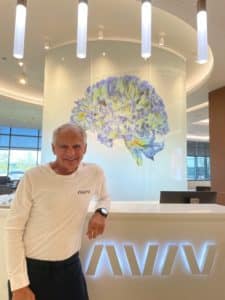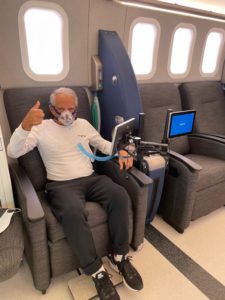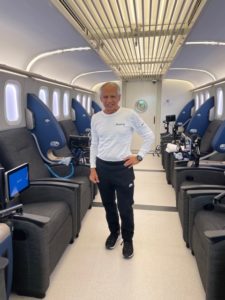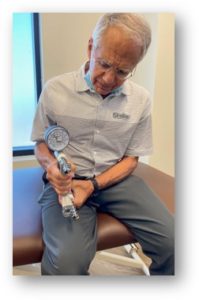
My Personal Journey to Florida’s Aviv Hyperbaric Clinic – By Joseph C. Maroon, MD, FACS*
In 1513, Spanish explorer Juan Ponce de León, traveled to Florida seeking the Fountain of Youth. Legend has it that magical waters, from a special spring, could reverse the aging process and cure sickness when swallowed or bathed. Such stories date back to the Greek writer and historian, Herodotus, who in the 5th century BC wrote of such a fountain.
In July of 2021, I also traveled to Florida and began my three-month quest for better health. Unlike both Juan Ponce de León and Herodotus, I was not seeking magical water but rather oxygen. Oxygen, like water which covers over two-thirds of the earth, has allowed life to flourish. The brain, despite only weighing about 3 lbs., consumes almost 1/4 of the oxygen our body uses. Oxygen, under pressure has potentially greater benefits and based on years of research and first-hand knowledge about the benefits of oxygen, specifically hyperbaric oxygen therapy (HBOT). My journey took me to central Florida, to the Aviv Hyperbaric Clinic. (Image to the left– Looking at the new AVIV lobby on my first day)
Florida’s Aviv Hyperbaric Clinic features a Medical Program developed by the Aviv team and Dr. Shai Efrati at Shamir Medical Center, one of Israel’s leading teaching hospitals. Dr. Efrati is the Director of the Sagol Center for Hyperbaric Medicine and Research where they have performed over 200,000 hyperbaric sessions to date. Dr. Efrati has treated over 1,000 clients with their current Aviv HBOT Protocol now being used in the Aviv Florida location. Dr. Efrati’s research has shown numerous body systems that have been improved with HBOT, including brain function. This includes both the injured and aging brain. I had read all of their scientific articles prior to making my decision to move to Florida for three months and I was impressed. But as a scientist I still needed objective data proving the benefits were for real. Thus, I essentially became a subject in my own study to determine HBOT’s benefits on ME!
In a three-part series, I will explain the science behind the benefits of HBOT and the results of the multitude of evaluations and tests I had before and after my 60 HBOT treatments over a three-month period during the summer of 2021. It was a fascinating journey and an experience that I believe has changed my life.
*Disclaimer – The HBOT treatments and testing done at Aviv Hyperbaric Clinic were paid completely by Dr. Maroon. This article is not a paid endorsement but is Dr. Maroon’s own impressions and experiences experienced during his HBOT treatments at Aviv.
PART ONE
What can be Learned from a Subject of One?
In 1976 William Sweet, professor of neurosurgery and chairman at Harvard, wrote, “I believe we have become excessively imbued with the conviction that multiple consonant observations are necessary before even tentative conclusions can be drawn from biological phenomena, that a randomized statistically significant series is necessary for firm conclusions. …we need to establish faith and the capacity of the biologist to reach a valid novel conception on the basis of one single set of facts. There is a staggering difference between zero and one when the one is a good idea.”
For eight years I have used hyperbaric oxygen therapy (HBOT) successfully, but anecdotally, to treat patients with post-concussion syndrome when all other measures failed. Impressed with the results, I set out on a self-experiment to obtain objective information on the effects of HBOT on neurocognition, cardiopulmonary function, anatomical brain imaging, proteomics and more. This time I became the patient and was hopeful to have similar improvements in brain and body function using my own well-used older self. (Image to the right – My first day looking at the HBO chamber. One of four chambers that could treat 12 people in each.)
Understanding Oxygen’s Role in Human Existence
Oxygen is the third-most abundant element in the universe but the majority is trapped in combination with other elements. The oceans produce oxygen through the phytoplankton, kelp and algae with in it and as a byproduct of photosynthesis. This has made it possible for humans and all life to survive and flourish. Earth’s atmosphere is 21% oxygen. HBOT uses 100% oxygen typically at two atmospheres or a pressure twice what we are exposed to at sea-level. HBOT involves breathing 100% pure oxygen in a special construct known as a HBOT chamber. The pressurized air in the chamber increases oxygen levels in the body 15 to 30 times higher than normal.
Traditional uses of HBOT are designed to speed up healing of carbon monoxide poisoning, gangrene, stubborn wounds, and infections in which tissues are starved for oxygen. The goal is to fill the blood and plasma with supplemental oxygen to help repair tissues. Typically, our bloodstream sends oxygen to tissues in our body through miles of blood vessels. For tissues exposed to HBOT, the combination of 100% oxygen and at higher pressure, increases oxygen-saturated blood to the wounded or infected tissues to speed healing.

Science has known for decades that the brain uses 20% of the cardiac output to supply a 4-pound organ. Thus 20% of the total oxygen we breath is used by the brain. This cellular activity, known as metabolism, far outpaces utilization by other types of cells in our body. Without oxygen for 7 minutes brain cells begin to die. The corollary question is would our brain work better if we were able to provide more oxygen to our brain cells? The answer thus far is Yes, with an interesting twist, and that’s where HBOT has shown brain benefits. (Image to the left – daily HBOT treatments lasted about 2 hours each. As part of the Protocol “brain games” were used throughout the sessions and results were used to compare day to day and month to month changes.)
HBOT has been considered a possible treatment for brain injury since the 1960s with studies showing short-term improvement in post-concussive and post-traumatic stress disorder symptoms. In August 2021, a large clinical trial, The Hyperbaric Oxygen Brain Injury Treatment Trial (HOBIT) was launched to determine whether hyper oxygen therapy would help to reduce brain injury in people who experienced severe blunt force trauma. Lead by the Hyperbaric Medicine Center at the Nebraska Medical Center, there are 11 centers around the nation taking part in a new multicenter phase II clinical trial that is aimed at reducing neurological damage in persons suffering from traumatic brain injuries.
In addition to brain trauma studies, research using HBOT for stroke patients has also shown brain benefits. Stroke is a sudden loss of blood supply to brain tissue from either a blocked or ruptured artery often causing a severe neurological deficit. Without the blood carrying life-giving oxygen to brain cells, these cells rapidly begin to die. In both animal and human studies, HBOT improves brain cell oxygenation, metabolism, the formation of new blood vessels, increased brain circulation and reduces inflammation. I have personally recommended HBOT to numerous patients who have suffered from prolonged post-concussion syndrome with residual headaches, insomnia, vision changes and foggy thinking. The results have been very positive with complete resolution of symptoms in many cases.
Understanding the Aging Brain
As we age many cellular changes occur throughout our body that may lead to decreased function in some and in others no discernable changes. Population-based autopsy studies of the brains of aged people, who had not been diagnosed with a neurological disease, show evidence of degeneration characterized by amyloid plaques, neurofibrillary tangles, synaptic atrophy, the loss of neurons and loss of brain volume. All are signs of neurodegeneration and hallmarks of diseases, like Alzheimer’s. The question is had these people really been functioning at their neurological best or if they had in fact lived longer would they soon be suffering from some type of cognitive deterioration?
As medical science improves the possibility of an ever-advancing life span, we may be entering a time where most organs could survive 100 years or longer, but there are few who believe our current therapies and treatments for brain preservation can match this optimistic goal and also maintain “normal” cognitive function.
There is no insurance or FDA approved drug, surgery or current treatment routinely used to treat or reverse brain degeneration once it has occurred. But what about treatments not approved by insurance companies?
Possibility of HBOT for the Aging Brain
The excitement surrounding HBOT for neuro-preservation has always been outside of the United States. Constraints by US insurance companies to pay for HBOT have not affected the research and use of HBOT in other counties. One such place is Israel. A small but aging population with similar demographics as the US, has had the benefit of the Sagol Center for Hyperbaric Medicine and Research, one of the largest HBOT centers in the world.
HBOT research has also shown brain benefits for improved cognitive function in healthy aging adults. (See multiple References below) Benefit explanations include improved brain blood flow, as seen on brain scans, and cellular DNA improvements using sophisticated blood tests. It has only been in the last 20 years that advanced brain scans and cellular biology testing has allowed scientists to look at changes in brain cell metabolic efficiency and cellular survival in the aging brain. Recently, positive results have confirmed significant improvements in human organ longevity with such factors such as exercise, lifestyle habits and diet.
Recent Scientific Results using HBOT for Improved Brain Function
Telomeres are the caps on chromosomes that prevent strands of DNA from “unwinding” during cell division, but they do become gradually shorter as we age. Once gone the cell no long can divide. The loss of telomeres is associated with aging and potentially shortened longevity as well as mutations and malignancy. A recent study of healthy adults over 64 years old who received 60 daily HBOT treatments at two atmospheric pressure (2ATA), reported significant increases in DNA telomere length and reduced number of senescent or zombie cells-cells no longer able to divide. HBOT research in both humans and human cell cultures have demonstrated increase in the expression of stem cells, reduced inflammatory markers, and improved mitochondrial biogenesis, angiogenesis and neurogenesis after therapy. (Image to the Right – As part of the Protocol Strength testing was done at the beginning and after 3 months of HBOT)
Cognitive Decline with Aging – More than half of community-dwelling individuals, sixty years and older, express concern about declining cognitive abilities. Besides common pathological declines such as in Alzheimer’s dementia and mild cognitive impairments, cognitive reduction is part of the normal aging condition. Processing speed, conceptual reasoning, memory and problem-solving activities are the main domains which decline gradually over time. Non pharmacological lifestyle interventions have included exercise, healthy diets and cognitive training, and all have shown positive effects on cognition if intensively performed.
HBOT research has shown clinical cognitive improvements in post-stroke, traumatic brain injury and anoxic brain damaged patients. A recent study published in 2020, showed in a controlled study, using 60 daily HBOT sessions at 2ATA, enhanced cognitive enhancements in healthy older adults. The study included 63 healthy adults (>64) randomized either to HBOT(n=33) or control arms(n=30) for three months. General cognitive function results were measured pre and post intervention. Neurocognitive improvements in the treatment group included attention, information processing speed and executive functions, all would typically decline with aging.
Cerebral blood flow (CBF) was increased in the HBOT group compared to the control group in the comparative regions. In a study investigating those who had suffered brain trauma, using special brain scans, HBOT resulted in enhanced brain microstructure recovery. Brain recovery encompassed both gray and white matter areas and demonstrated the development of new blood vessels as show by brain blood flow scans before and after HBOT. The average person treated was almost 10 years post brain trauma.
Summary PART ONE
This is much background on HBOT and the summary results of many thousands of research studies that have been done using it. But this information is what I needed, and more, in order to do not only something, I had never done myself before, but also to commit slightly over 3-months of time. In PART TWO, I will discuss the other organs that can benefit from HBOT. Additionally, I will explain the full Aviv Protocol of HBOT and other interventions, and the extensive battery of testing before and after the 3-months of HBOT. And finally, I will explain how the “twist”, used as part of the Aviv Protocol, potentially activates brain neurogenesis (the birth of new brain cells) and enhances the development of new brain cell connections. Important to know before undertaking this journey. In PART THREE, I will share my results before and after the 3-months of HBOT. I will explain why they are important and my overall impressions of my experience. So, stay tune, the journey is just getting started!
Precautions
Hyperbaric oxygen therapy is not for everyone. It should not be used by people who have had recent ear surgery or ear trauma, a cold or fever, or certain types of lung disease. The most common complication after HBOT is trauma to the middle ear. Other possible complications are eye damage and sinus problems. In rare, severe cases, a person can get oxygen poisoning. This can lead to seizures, fluid in the lungs, lung failure, or other problems. Considering the possible risks and benefits, the decision to use hyperbaric oxygen therapy must be carefully made after a detailed discussion with your healthcare provider.
References:
- Hadanny A, et al. Cognitive enhancement of healthy older adults using hyperbaric oxygen: a randomized controlled trial. Aging (Albany NY). 2020; 12:13740–61. https://doi.org/10.18632/aging.103571 [PubMed]
- Hachmo Y, ,et al. Hyperbaric oxygen therapy increases telomere length and decreases immunosenescence in isolated blood cells: a prospective trial. Aging (Albany NY). 2020; 12:22445-22456.
- Puhlmann LM, et al. Association of short-term change in leukocyte telomere length with cortical thickness and outcomes of mental training among healthy adults. JAMA Netw Open. 2019; 2:e199687.
- Fahy GM, Brooke RT, Watson JP, et.al. Reversal of epigenetic aging and immunosenescent trends in humans – Aging Cell Sept. 2019
- Salame, Yasmeen, et al. DNA Methylation Biomarkers in Aging and Age-Related Diseases, Front. Genet., 10 March 2020 | https://doi.org/10.3389/fgene.2020.00171
- Sigal Tal, et al. Hyperbaric Oxygen Therapy Can Induce Angiogenesis and Regeneration of Nerve Fibers in Traumatic Brain Injury Patients, Front. Hum. Neurosci., 19 October 2017 https://doi.org/10.3389/fnhum.2017.00508
- The Sagol Center for Hyperbaric Medicine and Research https://www.shamir.org/en/unique-pages-default-aspx/the-sagol-center-for-hyperbaric-medicine-and-research/
- Tony Wyss-Coray, Ageing, neurodegeneration and brain rejuvenation, 2016 November 10; 539(7628): 180–186. doi:10.1038/nature20411.
- Grant M. Liska, et al., A Dual Role for Hyperbaric Oxygen in Stroke Neuroprotection: Preconditioning of the Brain and Stem Cells, Cond Med. 2018 June ; 1(4): 151–166.
- Kelsey G.DeFrates, Unlocking mammalian regeneration through hypoxia inducible factor one alpha signaling, Biomaterials, Volume 269, February 2021, 120646
- Trial explores hyperoxygen therapy in brain injuries UNMC, https://www.unmc.edu/news.cfm?match=27749
- Hyperbaric Oxygen Therapy, Medscape, Updated: Nov 16, 2020, https://emedicine.medscape.com/article/1464149-overview
- Vadas D, Kalichman L, Hadanny A and Efrati S (2017) Hyperbaric Oxygen Environment Can Enhance Brain Activity and Multitasking Performance. Front. Integr. Neurosci. 11:25. doi: 10.3389/fnint.2017.00025
- Blaise Cozene, An Extra Breath of Fresh Air: Hyperbaric Oxygenation as a Stroke Therapeutic, Biomolecules 2020, 10, 1279; doi:10.3390/biom10091279
- AVIV CLINCS – https://aviv-clinics.com/
- Joseph C Maroon, MD, Jeffrey Bost, PA-C, Concussion Management at the NFL, College, High School, and Youth Sports Levels, Neurosurgery, Volume 58, Issue CN_suppl_1, September 2011, Pages 51–56, https://doi.org/10.1227/NEU.0b013e3182269efe
- Exercise in Older Adults Improves Cognitive Function, Front. Aging Neurosci., 29 October 2020 | https://doi.org/10.3389/fnagi.2020.590168
Posted on January 18, 2022 by Joseph Maroon in Blog, In The News, Tips on Healthy Living


